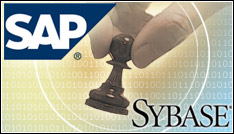

SAP is promising that its $5.8 billion (£3.7bn) acquisition of Sybase will start to return tangible benefits for customers within the next nine months when the two companies deliver a mobile business applications platform based on open standards that will run on many different mobile devices and operating systems.
Three months after announcing its buyout of Sybase, a 26-year-old producer of relational database software and mobile data management products, SAP brought together customers, industry analysts and media in Boston on 19 Aug. to discuss how the two companies will work together.
There, SAP officials confirmed an earlier promise to continue operating Sybase as an independent subsidiary and that John Chen would continue as Sybase CEO and assume an important position on the SAP management team.
Furthermore, the company confirmed that it will focus its joint product development in three areas: enterprise mobility, business analytics and enterprise information management. The overall goal of this product development will be to make SAP “the only company in the world to deliver the full suite of enterprise software and next-generation business intelligence on any device at any time” anywhere in the world, said SAP Co-CEO Bill McDermott.
Before the acquisition, SAP partnered with Sybase to bring the SAP Customer Relationship Management suite to mobile devices. A major driver of SAP’s decision to acquire Sybase was to meld the two companies’ technologies to bring the broader SAP Business Suite to a mobile environment, McDermott noted. Now the company is also promising to bring the company’s Business ByDesign Enterprise Resource Planning suite for small and midsize companies to its promised mobile platform.
It was clear that Sybase was already “a leader in Japan and especially China, which as we all know is now the second largest economy in the world and a place where we need to grow our business,” McDermott noted. Mobile technology has enabled business uses in China and Japan “to skip the desktop all together. In fact, mobile is the new desktop,” McDermott noted.
But while SAP and Sybase executives talk expansively about what the future will bring, analysts said that the 19 Aug. briefing was long on promises and short on explicit statements about how the two companies will integrate their product lines.
What SAP presented was “some directional announcements but not any clear road maps. It’s more about vision and strategy in terms of Sybase technologies and how SAP will integrate them,” said Paul Hamerman, vice president and principal analyst with Forrester Research. “What they’re saying is they have work to do to put this together.”
At the same time, it’s clear that “SAP sees a big future in mobile applications in terms of the user experiences that they offer as well as the freedom that they offer to move throughout the country to accelerate business processes,” Hamerman said.
Mobile business applications and mobile data analysis technologies are worthy of research and investment, Hamerman said, because “there will be some potentially breakthrough improvements in terms of using the capabilities of the device as well as the ability to be touched with business processes any time or anywhere.”
As a result, Hamerman believes that “CIOs and business people will start to consider the potential of mobile applications going forward. But I also think that the market has to mature in terms of being able to deliver more standardised, off-the-shelf type of applications” because it isn’t clear yet what SAP and other venders will eventually deliver.
For Albert Pang, president of the software industry research firm Apps Run the World, the question is whether SAP and Sybase can move quickly enough to keep up with the rapid development move globally to mobile applications.
In the near term, SAP’s mobile application strategy will be felt most “among some of the verticals SAP is trying to address, like banking, retail and telcos,” Pang said. “But the mobile market is just changing so quickly, will the customer be willing to wait” long enough for SAP and Sybase to get their full mobile application portfolio to the market? Pang asked. The move to mobile applications “is a mass migration that is going on right now. So I think that the SAP strategy is going to be more effective if it directs all of its energy toward these strategic verticals” as soon as possible, he said.
While SAP will benefit from its Sybase acquisition simply from gaining the revenue stream from the Sybase relational database and mobile data access technology, it’s uncertain whether the product road map the two companies presented on 19 Aug. will deliver the strategic market advantage they are looking for, said Pang. “I don’t think that we are going to have a good idea about whether the marriage of these two companies will bring tangible benefits to a large number of SAP customers” until 2011 or perhaps even later.
Denial from TSMC, after multiple reports it was in talks with Intel over a joint…
CEO Tim Cook talks to Trump official, as IDC notes China's smartphone market growth, and…
Another big name chip maker expects a hefty financial charge, after the US tightened rules…
More bad news for Google. Second time in less than a year that some part…
Federal office that tackled misinformation and disinformation from hostile nations is closed down, after criticism…
After Nvidia admits it will take $5.5 billion charge as Trump export limits of slower…